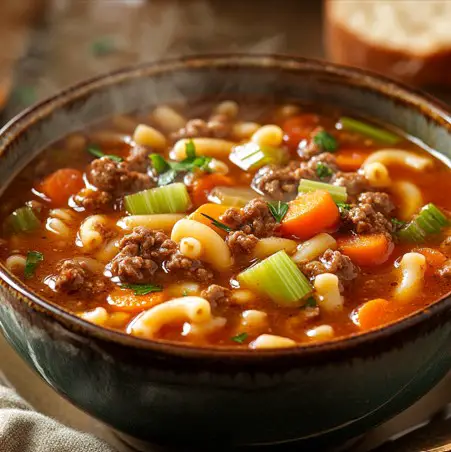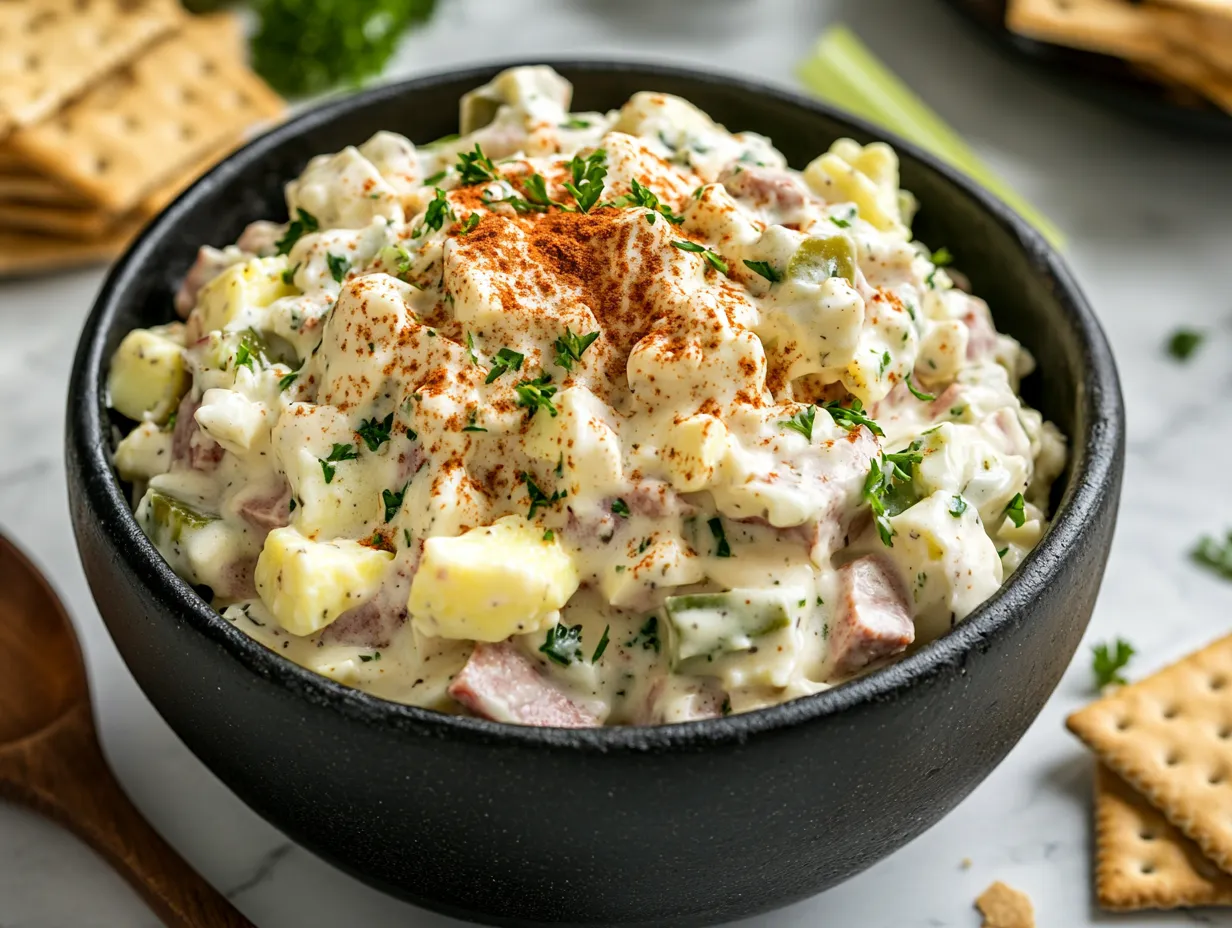Beef and macaroni soup is a timeless, heartwarming dish that brings together the savory flavors of ground beef, tender pasta, and rich, aromatic broth. This comforting soup is simple yet satisfying, providing a complete meal in one bowl. Combining the richness of beef with the mild chew of macaroni and the vibrancy of vegetables, it’s a family favorite that appeals to all ages. Whether you’re cooking for yourself or a crowd, this dish is easy to prepare and guaranteed to satisfy even the heartiest of appetites.
The Appeal of Hearty, Comforting Soups in Cold Weather
As the temperature drops, the craving for hearty and warm meals increases. Soups like beef and macaroni offer the perfect antidote to cold weather, wrapping you in warmth and comfort. The combination of rich flavors and steaming broth not only nourishes the body but also provides a sense of relaxation and homeliness, making it a go-to meal for winter evenings or rainy days. With its nourishing qualities and bold taste, this soup checks all the boxes when you’re seeking comfort.
Why This Recipe is Perfect for Weeknights and Family Meals
One of the great advantages of beef and macaroni soup is its simplicity, making it an ideal choice for busy weeknights. With minimal prep time and ingredients that can easily be found in your pantry or fridge, it’s a quick and wholesome option that fits perfectly into a hectic schedule. The recipe is also highly adaptable, allowing you to tweak it to fit personal tastes or dietary needs. Not only is it delicious, but it’s also budget-friendly, making it a practical choice for families. Plus, it’s a dish that can be scaled up easily for large gatherings or enjoyed as leftovers the next day.
Historical Background of Macaroni Soup
Origins of Macaroni in Soups and Its Popularity Worldwide
Macaroni, a versatile pasta shape, has a long and storied history dating back to the Mediterranean region, particularly Italy. While often associated with baked dishes like macaroni and cheese, it has also been used in soups for centuries due to its size, shape, and ability to absorb broth without losing its structure. Macaroni soups have found a place in various cultures across the globe, from Italian minestrone to American casseroles, as they offer a quick-cooking starch that pairs well with meats and vegetables in a liquid base.
The combination of pasta and broth creates a dish that is both filling and easy to digest, making it popular in homes around the world. Its simplicity makes it adaptable to a variety of ingredients, which has contributed to its enduring popularity. Whether in Italian households or American kitchens, macaroni soup is a dish with wide-reaching appeal due to its comforting nature and accessibility.
How the Combination of Beef and Macaroni Creates a Wholesome Meal
Beef and macaroni soup brings together two staples: ground beef, rich in protein, and pasta, a carbohydrate source. This combination ensures that the meal is balanced and nourishing, providing both energy and essential nutrients. The richness of the beef is complemented by the lightness of the macaroni, creating a dish that is not too heavy but still satisfying. The inclusion of vegetables in the soup adds further nutritional value, ensuring a well-rounded meal.
The flavor contrast between the savory beef and the soft, mild macaroni also plays a key role in making this soup so appealing. The pasta absorbs the flavors of the beef stock and seasonings, while still holding its own texture, creating a delightful mouthfeel that makes each bite comforting and satisfying.
The Influence of Different Cuisines on This Soup (Italian, American Comfort Food, etc.)
Beef and macaroni soup has roots in several cuisines. In Italy, minestrone and similar soups often incorporate small pasta shapes like ditalini or elbow macaroni, mixed with vegetables and sometimes beef. The American version of this dish has evolved into a more hearty, rustic form, often featuring ground beef, a rich broth, and plenty of vegetables, reflecting the country’s love of comfort food.
The use of Worcestershire sauce and dried herbs like oregano and basil in the recipe hints at a fusion of Italian and American influences, giving the soup a well-rounded flavor profile that appeals to diverse tastes. This blending of culinary traditions reflects the adaptability of the dish and its ability to cater to different palates across the world.
Ingredients Overview
Breakdown of Key Ingredients: Ground Beef, Beef Stock, Elbow Pasta, Vegetables
The core ingredients of beef and macaroni soup are simple but essential for creating the rich and hearty base of the dish. Prime ground beef provides a robust, savory flavor, while also delivering the protein needed to make this soup a complete meal. Choosing high-quality beef is key to achieving the best flavor.
Beef stock forms the backbone of the soup, lending depth and richness to the broth. A homemade or store-bought beef stock that’s rich in flavor will elevate the entire dish. Fresh tomatoes and sundried tomato puree add brightness and a touch of acidity, balancing the richness of the beef and stock. Elbow pasta is the traditional choice for its small, manageable size and ability to hold up in the broth without becoming mushy.
Lastly, quick-freeze garden vegetables, such as peas, carrots, and corn, not only bring color and texture to the soup but also add essential vitamins and minerals. They’re convenient and ensure that the dish remains balanced and nutritious.
Importance of Fresh and High-Quality Ingredients
Fresh, high-quality ingredients make a huge difference in the flavor and nutritional value of this dish. Opting for organic or grass-fed beef, ripe tomatoes, and flavorful stock ensures that the soup has a rich, well-developed taste. Using fresh herbs and spices, like crushed oregano and dried sweet basil, also enhances the depth of flavor, while avoiding artificial additives.
In addition, using quick-freeze garden vegetables allows for convenience without sacrificing nutrition. Flash-freezing vegetables preserves their nutrients, ensuring that they remain vibrant and full of vitamins even after being stored.
Nutritional Benefits of Each Component (Protein from Beef, Vitamins from Vegetables, etc.)
This soup is a nutrient-dense meal, providing a balance of protein, carbohydrates, vitamins, and minerals. The ground beef is rich in protein, iron, and essential amino acids, contributing to muscle growth and repair. The elbow pasta provides carbohydrates, fueling the body and providing lasting energy.
The vegetables, particularly the quick-freeze variety, are rich in vitamins A, C, and fiber, contributing to overall health and digestion. Meanwhile, the tomatoes bring antioxidants like lycopene, which promote heart health. Together, these ingredients create a balanced, wholesome dish that not only satisfies hunger but also supports a healthy diet.
Step-by-Step Cooking Process
Ingredients List and Preparation
Detailed List of Ingredients with Measurements and Substitutes
- 1-pound prime ground beef – Substitute with ground turkey, chicken, or plant-based alternatives for a lighter or vegetarian option.
- ½ cup finely chopped red onion – Substitute with white or yellow onion for a milder flavor.
- 6 cups rich beef stock – Use vegetable or chicken stock as a substitute if needed.
- 14 ounces fresh chopped tomatoes – Canned diced tomatoes can be used if fresh tomatoes are not available.
- 2 tablespoons sundried tomato puree – Tomato paste can be used as a substitute, though it may alter the flavor slightly.
- 1 teaspoon Worcestershire sauce – Adds umami; soy sauce or tamari can be substituted.
- ½ teaspoon crushed oregano – Dried oregano can be substituted with thyme or Italian seasoning.
- ½ teaspoon dried sweet basil – Fresh basil can be used in larger quantities if available.
- 1½ cups uncooked elbow pasta – Substitute with small shells, ditalini, or gluten-free pasta.
- 1½ cups quick-freeze garden vegetables – Any mixed vegetables like peas, carrots, and corn can be used.
Preparation Tips for Ingredients
- Beef: Use freshly ground beef for the best flavor and texture. For a leaner version, use ground turkey or chicken.
- Vegetables: If using fresh vegetables, chop them evenly to ensure they cook at the same rate.
- Onions: Finely chop the onion for even cooking and a smooth texture in the soup.
Step 1: Browning the Beef and Onions
Importance of Browning Beef to Enhance Flavor
Browning the beef is a crucial step in this recipe, as it builds the foundational flavor of the soup. The process of browning creates a Maillard reaction, which develops rich, deep flavors and adds complexity to the dish. When the beef caramelizes, it releases savory compounds that enhance the overall taste of the soup.
Techniques for Cooking Beef Until Perfectly Browned
To achieve perfectly browned beef, use a large, heavy-bottomed soup pot or Dutch oven. Heat the pot over medium-high heat before adding the beef. Avoid overcrowding the pan, as this will cause the beef to steam rather than brown. Break up the beef with a wooden spoon and allow it to cook undisturbed for a few minutes before stirring, so the surface has a chance to brown.
If excess fat accumulates during cooking, skim it off with a spoon or tilt the pot to remove it. This will prevent the soup from becoming too greasy while keeping the flavor concentrated.
Tips for Cooking Onions Until Translucent
Once the beef is browned, add the finely chopped onions. Lower the heat to medium and cook the onions slowly, stirring occasionally to prevent burning. The goal is to soften them until they become translucent, which usually takes about 3–4 minutes. Cooking onions at a lower temperature allows them to release their natural sweetness, adding depth to the soup without overwhelming the flavor of the beef.
Step 2: Adding the Flavor Base
Explanation of Adding Beef Stock, Tomatoes, Sundried Tomato Puree, Worcestershire Sauce, Oregano, and Basil
With the beef and onions perfectly cooked, it’s time to build the flavor base. Begin by pouring in the 6 cups of rich beef stock. This creates the liquid foundation of the soup, providing a deep, savory flavor that will be absorbed by the other ingredients. If you prefer a lighter broth, you can substitute with chicken or vegetable stock, but beef stock is ideal for maintaining the hearty, robust character of the dish.
Next, add the 14 ounces of chopped fresh tomatoes. These bring a touch of acidity to balance the richness of the beef, and their natural sweetness complements the savory components of the soup. The 2 tablespoons of sundried tomato puree will further intensify the tomato flavor, adding a concentrated depth that enhances the overall taste.
To round out the flavor, stir in 1 teaspoon of Worcestershire sauce. This adds a layer of umami, or savory richness, to the soup. ½ teaspoon of crushed oregano and ½ teaspoon of dried sweet basil contribute a fragrant, herbaceous quality, echoing the flavors of traditional Italian soups. The dried herbs will slowly release their flavors as the soup simmers, giving the broth complexity.
How These Ingredients Work Together to Build a Rich, Deep Flavor Profile
Together, these ingredients create a perfect harmony of flavors. The combination of savory beef, sweet tomatoes, and aromatic herbs forms a balanced and satisfying broth. The Worcestershire sauce adds a subtle umami kick, while the sundried tomato puree enhances the richness. The broth will thicken slightly as it simmers, allowing the pasta and vegetables to absorb these flavors for a cohesive dish.
Importance of Simmering to Allow Flavors to Meld
Once all the ingredients are in, bring the mixture to a gentle boil and then reduce the heat to a simmer. Simmering is crucial because it allows the flavors to meld and develop fully. Let the soup simmer for about 5 minutes to ensure the broth is flavorful before adding the remaining ingredients. During this time, the tomatoes will soften, and the herbs will infuse the broth, creating a deeply flavorful base for the pasta and vegetables.
Step 3: Cooking the Pasta and Vegetables
Introducing Elbow Pasta and Quick-Freeze Garden Vegetables into the Soup
After the broth has simmered and developed its flavors, it’s time to add the 1½ cups of uncooked elbow pasta and 1½ cups of quick-freeze garden vegetables. The pasta will absorb the rich broth, and the vegetables will cook to tender perfection, creating a hearty, filling soup. Quick-freeze vegetables are a convenient option because they retain their nutrients and texture, making them ideal for soups.
How to Ensure Pasta Is Cooked Al Dente
When cooking pasta in soup, it’s important to keep an eye on the cooking time to ensure it remains al dente, meaning it’s tender but still firm to the bite. Elbow pasta typically takes 7–8 minutes to cook in simmering liquid. Stir the soup occasionally to prevent the pasta from sticking together or to the bottom of the pot. Taste the pasta after about 7 minutes to check its doneness, and be cautious not to overcook, as it will continue to soften in the hot broth.
The Role of Vegetables in Adding Texture and Nutrients to the Soup
The addition of vegetables not only enhances the nutritional value of the soup but also adds a variety of textures. Vegetables like peas, carrots, and corn provide a slight crunch that contrasts with the soft pasta and tender beef, making each spoonful more interesting. They also bring a burst of color to the dish, making it visually appealing and more nutritious, as they are packed with vitamins A and C, as well as fiber.
Timing Tips to Prevent Overcooking Pasta and Vegetables
Since both pasta and vegetables cook quickly in hot broth, it’s essential to monitor the soup closely. Add the pasta and vegetables after the broth has been simmering for a few minutes to avoid overcooking. If using fresh vegetables, cut them into smaller, even pieces to match the cooking time of the pasta. Once the pasta is al dente and the vegetables are tender, remove the soup from heat to avoid further cooking.
Final Adjustments and Serving
Adding Salt, Pepper, and Optional Seasonings to Taste
Once the pasta and vegetables are perfectly cooked, taste the soup and adjust the seasoning. Add salt and freshly cracked black pepper as needed to enhance the flavors. If you prefer a bit more depth, consider adding a pinch of red pepper flakes for heat, or a dash of smoked paprika for a smoky finish. Stir the soup well to evenly distribute the seasoning.
Suggestions for Garnishing (Cheese, Herbs)
To elevate the dish further, serve the soup with garnishes. A handful of freshly shredded cheese, such as Parmesan, cheddar, or mozzarella, adds a creamy richness that complements the savory broth. Fresh herbs like parsley or basil can also be sprinkled on top for a burst of color and fresh flavor.
Serving Tips: Pairing with Crusty Bread, Serving Size Suggestions, and Presentation Ideas
Beef and macaroni soup pairs wonderfully with warm, crusty bread, which can be used to soak up the flavorful broth. Serve the soup in large bowls, making sure each portion contains a balance of beef, pasta, and vegetables. For a more filling meal, consider adding a side salad or a loaf of garlic bread. Presentation-wise, a sprig of fresh herbs or a drizzle of olive oil can make the dish look more polished and inviting.
Variations and Customizations
Meat Substitutes and Variations
Using Turkey, Chicken, or Plant-Based Beef Alternatives
For a lighter version of beef and macaroni soup, ground turkey or chicken are excellent substitutes. Both meats are leaner than beef, which reduces the fat content while maintaining a similar texture. Ground turkey offers a milder flavor, allowing the herbs and seasonings to stand out more, while chicken provides a slightly richer taste.
Plant-based beef alternatives are another great option for those following a vegetarian or vegan diet. Brands that replicate the texture and flavor of ground beef can be seamlessly swapped into the recipe. These alternatives are usually protein-rich and work well in soups, maintaining the same hearty quality without the use of animal products. Flavor-wise, the plant-based alternatives tend to have a lighter taste, but the broth and seasonings can be adjusted to enhance richness.
Pasta and Vegetable Swaps
Alternative Pasta Shapes and Gluten-Free Options
While elbow pasta is the traditional choice for this recipe, other small pasta shapes can be used to change up the texture. Ditalini, small shells, or farfalle (bowties) work just as well. For gluten-free options, use gluten-free pasta, which is widely available in various shapes. Chickpea or lentil-based pasta can also be used, offering more protein and fiber while keeping the dish gluten-free.
Seasonal Vegetable Additions
To keep the soup seasonal and fresh, you can swap in vegetables like spinach, bell peppers, or zucchini. These vegetables cook quickly and add vibrant colors and flavors to the dish. Root vegetables like butternut squash or sweet potatoes are also great options for fall or winter, making the soup heartier and more seasonal.
Spicing it Up
Adding Chili Flakes or Smoked Paprika for a Spicy Kick
For those who enjoy a bit of heat, adding chili flakes or smoked paprika can transform the soup into a spicier version. Smoked paprika, in particular, adds a subtle smokiness that complements the beef and elevates the flavor profile. You can adjust the heat level according to your preference.
Use of Different Herbs and Spices for More Complex Flavor Profiles
Experimenting with different herbs and spices can add depth to the soup. Try adding thyme, rosemary, or bay leaves for a more herbaceous flavor. Cumin or coriander can lend an earthier, more aromatic profile, making the soup even more comforting and flavorful. The beauty of this recipe lies in its versatility, allowing you to tailor it to your tastes and preferences.
Frequently Asked Questions (FAQs) (100 words)
Can I freeze this soup for later?
Yes, this soup freezes well. Let it cool completely before transferring to airtight containers. Freeze for up to 3 months. To reheat, thaw overnight in the refrigerator and warm on the stove over medium heat. Add a little extra stock if needed to thin it out.
What can I use instead of elbow pasta?
Ditalini, small shells, or gluten-free pasta work well as alternatives.
How can I make the soup thicker or thinner?
To thicken, simmer longer to reduce the liquid. To thin it out, add more stock or water.
What cheese pairs well with this soup?
Parmesan, cheddar, and mozzarella all complement the flavors beautifully.
Print
Beef and Macaroni Soup
Description
This Beef and Macaroni Soup is the ultimate comfort food, perfect for cold nights or when you need a quick and satisfying meal. The rich beef stock, tender ground beef, and al dente macaroni combine with a medley of vegetables to create a hearty, nutritious soup that’s brimming with flavor. It’s easy to make, customizable to your liking, and great for feeding a family or meal prepping for the week. With each spoonful, you’ll enjoy a delicious balance of savory beef, fresh vegetables, and perfectly cooked pasta.
Ingredients
- 1 pound prime ground beef
- ½ cup finely chopped red onion
- 6 cups rich beef stock
- 14 ounces fresh chopped tomatoes
- 2 tablespoons sundried tomato puree
- 1 teaspoon traditional Worcestershire sauce
- ½ teaspoon crushed oregano
- ½ teaspoon dried sweet basil
- 1 ½ cups uncooked elbow pasta
- 1 ½ cups quick-freeze garden vegetables
Instructions
- In a robust soup cauldron, marry the beef and red onions, cooking until the beef is perfectly browned and the onions translucent. Skim off any extra fat, ensuring a lean soup base.
- Pour in the beef stock, introducing the freshly chopped tomatoes, the deep sundried tomato puree, Worcestershire sauce, and a sprinkle of crushed oregano and sweet basil. Stir this mixture with love and let it come to a gentle boil. Lower the heat and let it simmer for about 5 minutes, allowing the flavors to mingle.
- As aromas fill your kitchen, introduce the elbow pasta and the garden vegetables to the pot. Allow them to simmer for roughly 8 minutes. The pasta should be tender to the bite but still hold its shape.
- Season with salt and freshly cracked pepper as per your palate. Give it a good stir.
- Pour into bowls and, for those who desire, sprinkle a handful of freshly shredded cheese atop. Serve with warm crusty bread for a meal that wraps you in warmth.
Notes
- Cooking Time: This recipe takes about 30 minutes to prepare and cook, making it ideal for a weeknight dinner.
- Storage: The soup can be stored in an airtight container in the refrigerator for up to 3 days. It also freezes well for up to 3 months.
- Reheating Tips: When reheating, add a splash of water or stock to adjust the consistency, as the pasta may absorb some of the liquid over time.
- Customization: Feel free to modify the vegetables based on what’s in season or available. You can also swap out the ground beef for ground turkey, chicken, or a plant-based alternative for a lighter or vegetarian version. Adjust the seasonings and herbs to suit your palate.
- Serving Suggestions: Serve the soup with a side of warm, crusty bread for a complete meal. Top with shredded cheese or fresh herbs for an extra layer of flavor.
- Pro Tip: To prevent the pasta from becoming too soft, cook it separately and add it to the soup just before serving if you plan on making this dish ahead of time or storing leftovers. This will maintain the pasta’s texture over multiple meals.









